Front doors are our first defence against a lot, particularly during the wet and windy Autumn and Winter months.
Maintaining your external doors properly helps prepare them for changes in temperature and weather, preserving their condition in time for colder, wetter weather.
So, whether you’ve recently refreshed your doors and want to keep them in great condition during winter, or you simply want to give your old doors a dose of TLC, this guide is here to help.
Wooden, uPVC or composite?
As you might imagine, different types of doors will require different maintenance and care to keep them looking and performing at their best.
As a natural product, wooden doors require more upkeep than uPVC or composite alternatives. A wooden door needs to be properly maintained and protected against weather conditions that can warp, rot and damage the door.
Alternative materials may require less maintenance. However, to achieve a natural look and benefits such as improved sound and heat insulation timber is the best choice. The appearance of timber can often sway people into choosing timber over other materials so a little maintenance can go a long way in the overall aesthetics of your home.
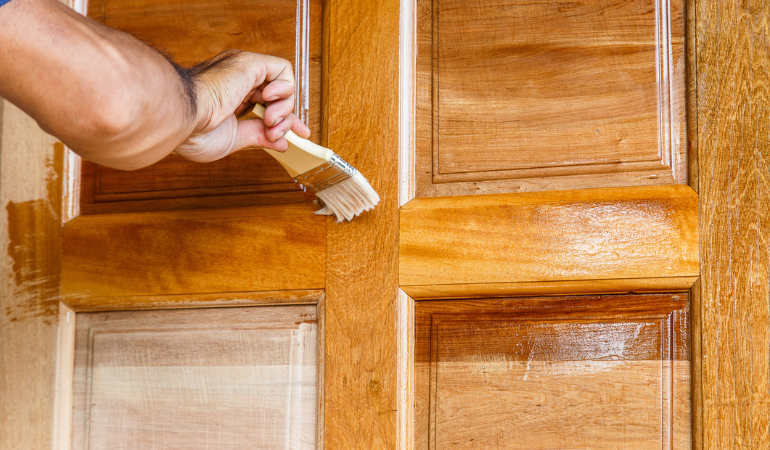
How to varnish or stain doors
If you have opted for a wooden door, a varnish can help reinforce the wood's natural structure and protect it against scratching, marking or weather damage. Varnish is great for waterproofing wood, helping prevent wood rot or moulding due to water soaking into the wood itself and becoming trapped.
Prepping the door
Before applying any varnish, take a dry soft cloth and wipe the surface of the door removing any debris, dust or dirt on the door. Make sure you get into the panels and mouldings to remove any dust sitting in the corners.
Varnishing the door
Once clean, start applying the varnish in the direction of the natural woodgrain. Dip your paintbrush at least halfway into the varnish and wipe off any excess on the edge of the container. Start by applying the varnish to the panels and mouldings first, helping create a more even application and coverage when dry. Avoid overlapping your brush strokes and move quickly once the product is on the door to avoid uneven coating.
Extra coats
We recommend applying at least two coats of varnish for good protection and coverage, sometimes even a third for additional protection and durability against harsh weather.
Once the first coat is dry, gently buff the wood using fine sanding paper and remove any dust and debris with a dry cloth as before. Apply the second coat using the same process as all other coats and leave to dry.
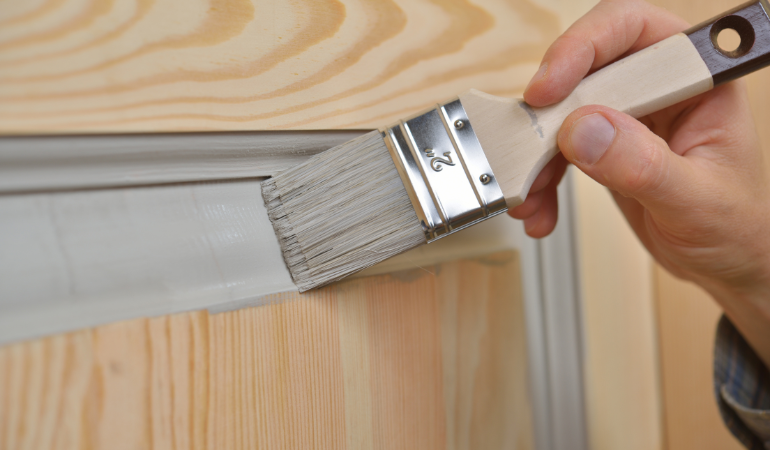
How to paint doors?
Front door paint or internal door paints can completely transform your doors for a new look without the cost. When done correctly, painting your external doors can also give them a helping hand against the elements.
Prepping the door
For a wooden door, you will need to fill any holes, sand the entire door and apply a primer (depending on the paint being used) before applying any paint.
UPVC doors only require a small amount of light sanding to provide an edge for the paint to adhere to for a lasting finish. We also recommend applying a primer to increase the durability of the finish.
Take a soft, dry cloth and wipe down the door after prepping to remove any dust or debris that may sit under the paint.
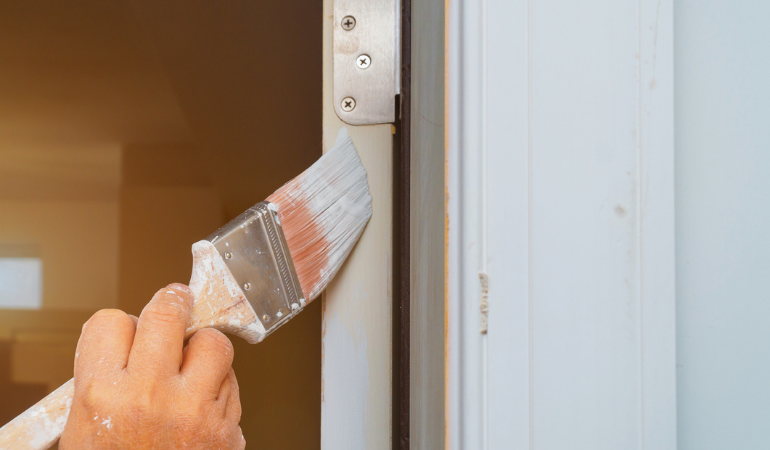
Painting a panelled door
If the door is panelled, start with the inner panels first, moving onto the mouldings and the remainder of the door, finish with the exposed edges of the door. We recommend painting in with the grain of the door and working in coats to build up colour.
Painting a glazed door
If you’ve got a glazed front door, tape off the glazing using decorating tape or masking tape to ensure no paint marks the glass panels. Then start on the mouldings before painting the middle, top and bottom rails. Finally, paint the stile (remaining door) and the edges of the door that are exposed.
Painting a solid door
If your door is solid with no panelling or glazing, section the door off into 8 sections (2x4) along the top and bottom of the door. Work down these sections in consecutive order using the natural grain as a guide. Make sure that you are blending the sections out to avoid any harsh edges, this should be done when the paint is still wet.
How to clean doors?
Cleaning your doors regularly can prevent dirt and debris from staining or marking your doors. Cleaning with the right solutions will protect your varnish, wood, uPVC or paint coverings while still removing stubborn dirt and marks.
Cleaning a wooden door
Using a dry or slightly damp cloth dust the door for any loose debris or dust, removing these at this stage prevents them from scratching the door during the deeper clean.
To a bowl of warm water add mild household soap such as dish soap and soak a soft cloth or sponge in the soapy water. Ring out the excess water and scrub your door starting at the top so dirty water won’t run down the door into areas already cleaned. Repeat the process of soaking and ringing the cloth (changing the water if necessary) until the entire door is clear of dirt. Finish the process by running a damp cloth around the edges of the door to remove any dirt that you might not see when the door is closed.
Once it’s clean and dry you can also add polish or wax for shine and gloss to the wood.
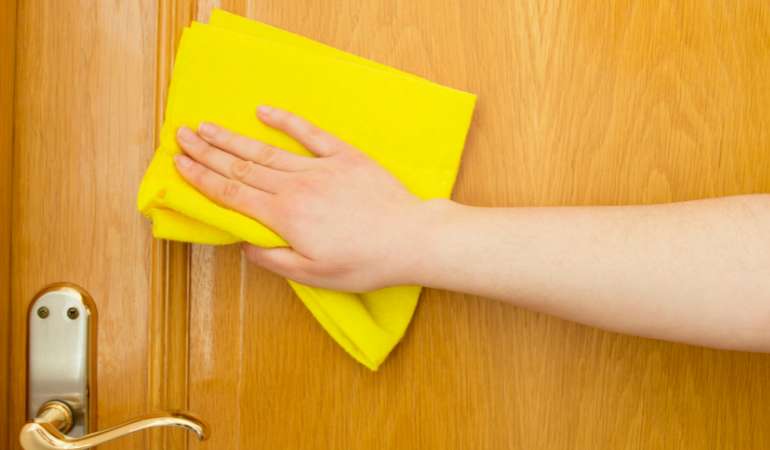
Cleaning a uPVC door
To clean a uPVC door use soapy water (usually dish soap) and a soft cloth that won’t scratch the surface of the plastic.
Soak the cloth in the soapy water and start on the mouldings of the door (from the bottom up) to dislodge any dirt and debris in the crevices of the door design. Then proceed with the rest of the door, working from the bottom up to save time and prevent dirty areas from leaking into clean ones.
How to seal doors
All doors come fitted with a weatherproofing seal which should typically last you between 10 and 20 years. If you’ve recently moved into another home and notice draughtiness, leaking or other indications of a damaged seal it may be time to replace it. Alternatively, if it’s been a while since you had your doors fitted, it can be a good idea to check and replace the seal.
Prepping the doorway
Make sure the doorway is clean and clear of debris before starting to apply any seal or products. Using a damp cloth, run along the inside of the doorframe from top to bottom, paying special attention to the corners where dust and debris may collect.
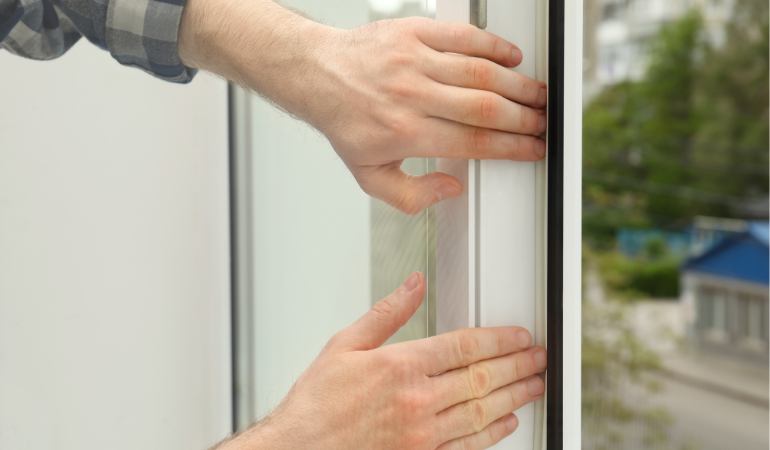
Sealing the doorway
Apply the adhesive door seal strip to the inside of the doorframe starting at one side first. Push the end of the adhesive strip right into the top corner, ensuring the strip sits flush with the door jamb. Work the adhesive strip all the way to the bottom of the doorframe, making sure this is stuck down well and cut to size once you’ve reached the bottom.
Repeat for the other side of the door frame and the top.
How to weatherproof doors
A lot of people think that weatherproofing your doors will be an expensive addition to your doors, but it needn’t be and will save you money on energy bills in the long run. There are several ways you can protect your doors against the weather and in turn, increase security and energy efficiency.
Install a draught excluder
A fitted draught excluder is a metal plate that is installed along the bottom of your door and is fitted with bristles or bendy plastic that stop draughts, rainwater and dirt such as leaves blowing under your doors into your home. Draught excluders are not expensive to buy or difficult to install and can be a great way of keeping your doors in good condition and keeping the cold weather out.
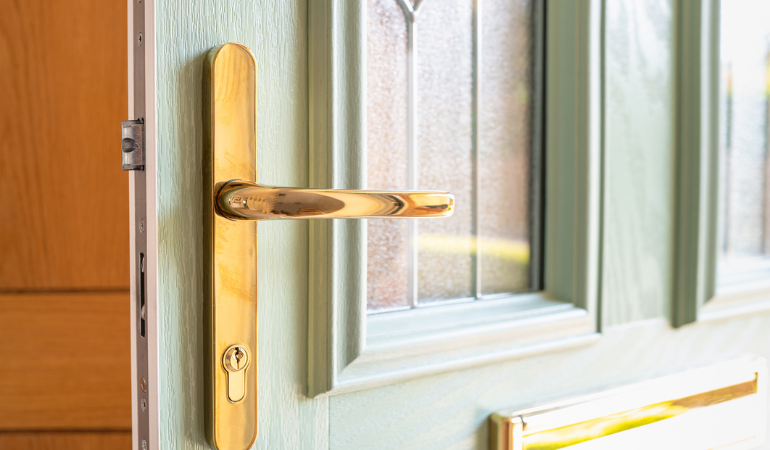
Install a letterbox guard
If you’ve got a letter box on your front door, this is a prime area for draughts and water to enter the home during colder months. Letterbox guards or draught excluders work in the same way as the larger versions and are installed on the inside of the letterbox to prevent cold air from entering the home.
Check and change your hardware/ironmongery
Just as doors wear over time, hardware such as door locks, handles and hinges can wear too with constant use over the years. If these wear too much the door can sit in the frame wrong, becoming looser and looser as time goes on.
Check your door by giving it a little wiggle, if there is more movement than previously or a lot of movement that’s a good sign that your hardware is starting to wear or has already worn away. Updating door locks and handles not only improves the security of your external doors but helps the door sit flush in the frame ensuring that other elements such as weatherproof seals, draught excluders and thresholds are working as they should.
Next Steps/Conclusion
Without proper maintenance, your external doors will start to underperform becoming less energy efficient, less safe and less aesthetically pleasing. We recommend starting to care for your doors as soon as they’re installed making sure you preserve them at their best.
At Doordeals we stock a huge range of doors from solid wood, to glazed and even custom sized doors, so whatever your style or budget you’ll find a high-quality door at the right price for you. Our range of accessories and door care options make it easy to buy everything you need in one place, so you’re ready to go as soon as your door is installed.
If you’ve got any additional questions about aftercare and maintenance, get in touch with our team and we’ll try our best to help you out or download our full door care document for more tips and advice.
